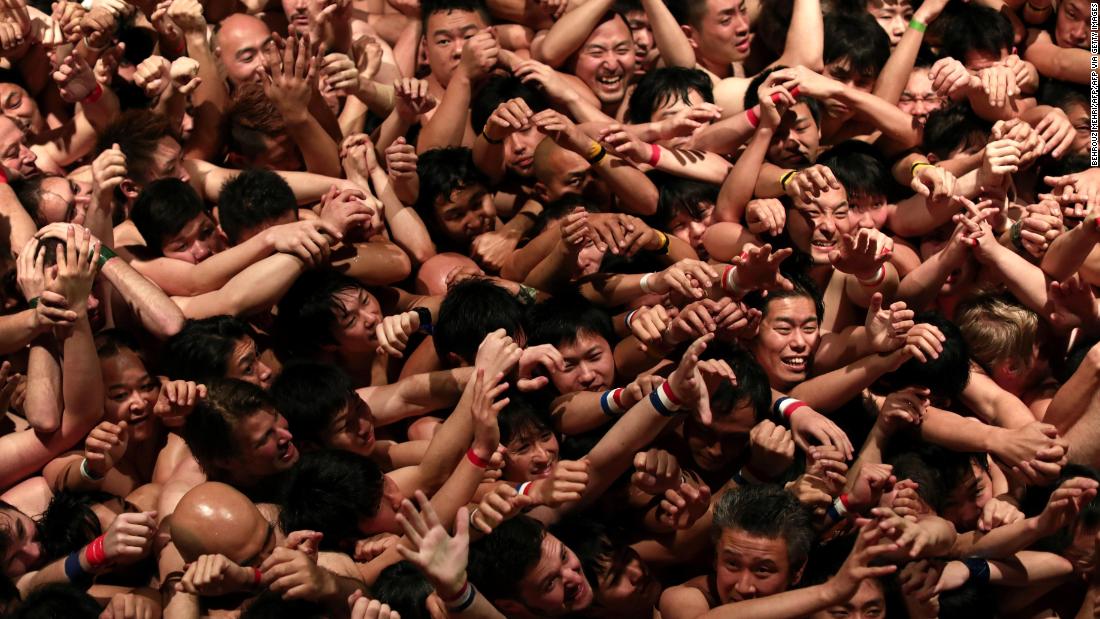
(CNN) – This time a year ago, thousands of people gathered at Japan’s annual Hadaka Matsuri celebration – also popularly known as the “Nude Festival” – in Okayama Prefecture, in the southern part of Honshu Island.
In the current climate of social distancing, the highlights of last year’s event (see above) are a surreal reminder of how much has changed since then.
Also known as Saidaiji Eyo, Hadaka Matsuri takes place on the third Saturday in February at Saidaiji Kannonin Temple, about a 30-minute train ride from Okayama City. And this year was no exception.
But the Covid-19 pandemic has left its long shadow in the 2021 proceedings, forcing organizers to significantly reduce things.
A battle between 10,000 men
Hadaka Matsuri celebrates the blessings of an abundant harvest, prosperity and fertility.
In normal times, it starts in the mid-afternoon with an event for young boys, with the aim of encouraging the interest of the younger generations. In the evening, the approximately 10,000 male participants spend an hour or two running around the temple precinct preparing and purifying themselves with cold, frozen water, before hiding in the main temple building.
They are not as naked as the name of the festival indicates. They wear a minimal amount of clothing; usually a Japanese loincloth called “fundoshi” and a pair of white socks called “tabi.”

In this image taken on February 18, 2017, the faithful expect the priest to throw the sacred clubs during the annual Hadaka Matsuri at Saidaiji Temple in Okayama.
BEHROUZ MORE / AFP / AFP via Getty Images
When the lights go out at ten o’clock at night, a priest throws 100 bundles of twigs and two lucky sacred shingi sticks 20 inches long into the crowd from a window four feet above.
It is a scene that would be unthinkable today. The men, packed like sardines, sink into each other to grab one of the bundles and / or the two sticks. According to legend, everyone who succeeds is guaranteed a year of good fortune. (Shingi are more sought after than less coveted branches, which can be taken home.)
The whole event lasts about 30 minutes and participants come out with some cuts, bruises and sprains of the joints.
Visitors usually come from all over Japan and a few from abroad to participate.
But event organizers confirmed to CNN Travel that this year’s Hadaka Matsuri event, which took place on February 20, was limited to a select and socially distanced group of about 100 men who had taken the shingi. in recent years and it was closed to spectators.
Instead of fighting for the batons, the men gathered at Saidaiji Kannonin Temple to pray for fertility, the end of the pandemic and world peace, while observing security measures, including social distances.
Uninterrupted for 500 years

As part of the Nude Festival, participants are purified with cold, icy water before entering the main temple.
Trevor Williams / Getty Images AsiaPac / Getty Images
Why not cancel the entire event?
In a statement that revealed its reasons for moving forward with a severely scaled-down version of the festival, organizers noted that it has continued uninterruptedly for more than 500 years.
“In a discussion with the priest chaplain and committee members, we have come to the conclusion that we must now pray (for) Eyo,” said Minoru Omori, chairman of Saijaiji Eyo. Eyo refers to a term called “ichiyo-raifuku,” which means “to withstand the cold and harsh winter and to reach the heat of spring.”
“In other words, we pray for good luck after the continuous bad things,” Omori said.
The nude festival evolved from a ritual that began 500 years ago during the Muromachi period (1338-1573), when villagers competed to grab paper talismans, which a priest delivered to the Saidaiji Kannonin temple.
More and more villagers wanted those lucky paper talismans and the ritual grew. But they realized that when they went to pick up the paper it was torn. Their clothes were also hampered, so they eventually ran out of them and changed roles for wood, Okayama Tourism Board spokeswoman Mieko Itano explained in a 2020 interview on CNN Travel.
With its long heritage, the festival was also designated an important important intangible cultural asset in 2016. It is one of several “nude festivals” held throughout Japan, with another held in Yotsukaido, Chiba Prefecture, with men in tapas. of fighting fighting and carrying children through the mud as a method of exorcism.
Japan and Covid-19
Daily cases of Covid-19 have declined in recent weeks in Japan, although Tokyo is among several prefectures in a state of emergency to control the virus. The country has reported more than 424,000 cases of Covid-19 and more than 7,000 deaths.
The pandemic forced organizers to postpone the Tokyo 2020 Summer Olympics last year, and the games would begin on July 23, 2021.